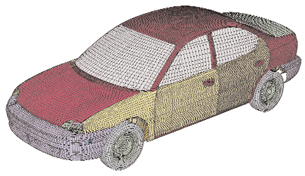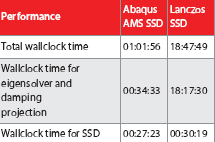Latest News
June 1, 2008
By Charlie Chin
 Figure 1: This FEAmodel, provided by the National Highway and Traffic Safety Administration, was used as the starting point for a full body noise and vibration (N&V) analysis using Abaqus unifiedFEA software from SIMULIA. |
That satisfying “thud” you hear when you shut the door of a luxury car is no accident. Nor is the smooth sensation you feel when driving down the highway at cruising speed. That’s because noise and vibration (N&V) evaluation has helped design engineers quantify and manipulate these kinds of subjective — yet very real — attributes of “pleasability” in a vehicle.
Not surprisingly, competitive pressures in the automotive industry are leading to increased demand for rapid assessment of noise and vibration levels in the early product design stages. Recent developments in large model finite element analysis (FEA) software are making such tasks easier, faster, and more accurate than ever.
Over the years, automotive manufacturers have used increasingly sophisticated computer-aided engineering (CAE) tools to improve the design and evaluation process of new vehicle models while minimizing physical prototype testing. Particularly in the case of N&V, more detailed modeling of a complete car body is desired because it allows adjustment of a wide range of factors that can affect customer comfort — and how well a new car may sell.
 Figure 2: In a large FEAmodel, such as thiscomplete vehicle with several milliondegrees of freedom, the automatic multilevelsubstructuring (AMS) technologywithin Abaqus FEA software dramaticallyreduces the effort and time required toperform N&V analysis. |
Parameters of N&V
Noise, to human ears, is the perception of sound between 20Hz and 20,000Hz. Vibration of a structure can be felt by the human body as repetitive movement at much lower frequencies. N&V issues in the automotive industry are classified as either structure-borne or airborne, depending on the path that a sound or vibration wave follows. Structure-borne noise (from the powertrain, chassis, etc.) can be modified with isolation materials that reduce the transmission of energy between structural elements, or with damping materials to dissipate the energy. Airborne noise (from exhaust, wind, etc.) can be modified with barrier materials that block the passage of sound energy, or with absorption materials that dissipate acoustical energy. The response of a full vehicle to these structural and airborne consequences of road input and powertrain excitation is a problem of great interest to automotive design engineers.
The computational analysis of automotive N&V is most often performed with mode-based FEA, which incorporates the natural vibration frequencies and/or specific vibration patterns of the structures being studied. The accuracy of the analysis increases if the frequencies being studied span a wider range of the audible spectrum, but achieving such accuracy requires bigger models. As model size increases, the use of more efficient numerical techniques helps keep analysis times down and the working cycle short.
 Figure 3: Simulation results of the acoustic cavity of a car body using Abaqus FEA software illustrate the air pressure distribution for the second acoustic eigenmode at 79.6Hz. This data can be combined with the structural model in Figure 2 to provide a structural-acoustic N&V simulation of the full vehicle with about 2.3million degrees of freedom. |
Nonlinear FEA Improves Accuracy/Cuts Time
Traditionally, linear FEA analysis methods have been used to evaluate N&V. However, the linear methodology does not give as complete a picture of the N&V profile of a car as can be gained with a nonlinear analysis solution, which provides simulation results closer to real-world behavior.
Although some components of a car, such as suspension control arms, are essentially linear, the behavior of many vehicle components, particularly under assembly loads, is nonlinear. As a result, users who rely solely on linear methods routinely accept a number of uncertainties, and therefore possible inaccuracies, related to things like nonproportional damping, nonlinear connections such as bushings and hyperelastic materials, and other varying physical properties.
Abaqus unified FEA software, however, provides both linear modeling capabilities and nonlinear tools for predicting N&V effects from a wide variety of components including bushings, rubber bearings, damping materials, mesh-independent fasteners, contact friction effects, structural acoustics, and even rolling tires.
High-performance computing (HPC) has contributed significant power to these enhanced FEA capabilities: solving large- body modeling problems, using an Abaqus automatic multilevel substructuring (AMS) eigensolver, followed by a steady-state dynamic (SSD) analysis, can now be accomplished in an hour or two, versus 13-18 hours with other solvers.
 Figure 4: The highly nonlinear behavior ofrolling tires has a significant effect on vehicleN&V. The new release of Abaqus 6.8 includesexpanded multiphysics capabilities thatallow for a higher fidelity representation ofthe dynamics of rolling tires. |
Creating Large Models for N&V Analysis
As an example of this enhanced FEA capability, let’s look at a typical N&V analysis of a full-vehicle model. An initial FEA model (see Figure 1) was provided by the National Highway and Traffic Safety Administration (NHTSA). Since the original model was created for crash analysis, some additional minor modifications were made to make the final meshed model available for N&V analysis with Abaqus.
First, a structural analysis of the vehicle was performed using a vibration system model of a trimmed body and rolling chassis (see Figure 2). In this analysis, the tires of the vehicle are simulated with concentrated, i.e. stationary, loads applied to the pivot points on the knuckles of the front wheels. This large structural model has 271,872 elements and 1,703,161 active degrees of freedom. Performance targets for vehicle N&V analysis are set up based on a combination of competitive benchmarking, customer research, and government regulations. The upper bound of the frequency extraction range was chosen as 450Hz, and the frequency response solutions are computed up to 300Hz.
Next, a model of the acoustic cavity, or air volume, of the car (see Figure 3) was created by discretizing the space inside the vehicle and then combining the resulting mesh with that of the previous structural model. It is not necessary for the structural and acoustic regions to share nodes: they are linked via surface-based tie constraints that join the structural and acoustic meshes.
The acoustic portion of the model uses 843,752 tetrahedral acoustic elements. The total number of degrees of freedom in this combined structural-acoustic model is approximately 2.3 million.
Testing Against Other Solutions
When testing the model, the acoustic pressure was monitored near the vicinity of the driver’s ear to assess the noise level inside the vehicle. The mode-based SSD analysis in Abaqus consisted of two steps: a frequency extraction with the AMS eigensolver followed by a frequency response calculation. This allows for the inclusion of dissipative effects and the use of viscous and structural damping at global, material, and element levels.
The accuracy of the model was very good. At 12 selected frequencies, the acoustic pressures computed by the SSD analysis were almost identical to other direct solution and Lanczos-based procedures used for comparison.
In addition, the Abaqus results were obtained in substantially less time: one hour vs. 18 hours (see Table 1, page 71). This greatly improved performance, while maintaining accuracy, demonstrates strong potential for practical industrial simulations.
 Table 1: This table compares performance data for steady-state dynamics (SSD) analyses conducted with the AMS versus a Lanczos eigensolver.While the accuracy of both models was nearly identical, the AMS eigensolver produced results in about an hour while the Lanczos analysis took morethan 18 hours. |
Enhanced Tire Dynamics
In the models discussed here, tires are defined as a stationary, vertical load on the model, which is the assumption of a traditional N&V analysis. However, as of May 2008, the new release of Abaqus Version 6.8 includes expanded multiphysics capabilities that allow for a much more accurate representation of the dynamics of both rolling tires and their internal rotating pressurized acoustic air cavity, which contribute loads in the fore-aft direction as well as the vertical.
A tire itself is a very nonlinear, elastic object and the gyroscopic effect of a rolling tire and internal air has a major effect on the noise-vibration prediction (see Figure 4). This effect can now be incorporated into a full-body N&V analysis.
A benefit of these new modeling capabilities in Abaqus 6.8 is that tire manufacturers can provide automotive designers with much more comprehensive, richer numeric representations of their tire’s behavior — without divulging their detailed tire FEA models.
Expanded FEA capabilities such as these are leading to a new era in modern automotive design engineering. Recent exponential growth in HPC capacity allows for both finer meshing and shorter compute times. Unified FEA software and increasingly powerful multiphysics capabilities from SIMULIA provide powerful tools for modeling a wide range of automotive components. These can now be brought together into vehicle simulations that are larger, more complex, and more realistic.
Charlie Chin, Ph.D., is a senior engineering specialist for SIMULIA. You can send e-mail about this article to [email protected].
Info:
Abaqus
SIMULIA
Providence, RI
Subscribe to our FREE magazine, FREE email newsletters or both!
Latest News
About the Author
DE’s editors contribute news and new product announcements to Digital Engineering.
Press releases may be sent to them via [email protected].






